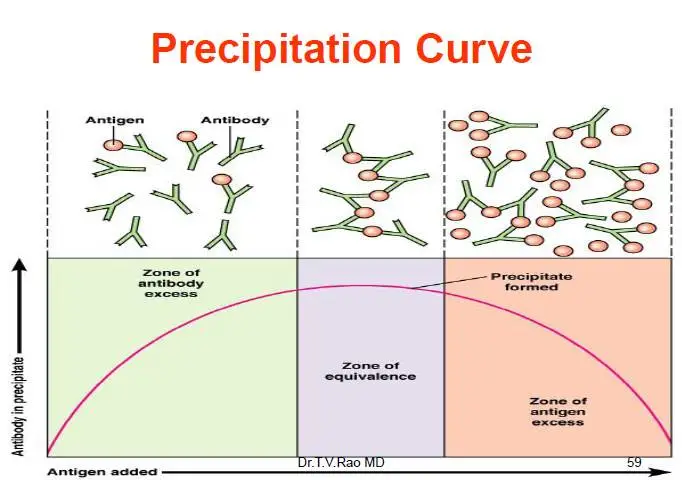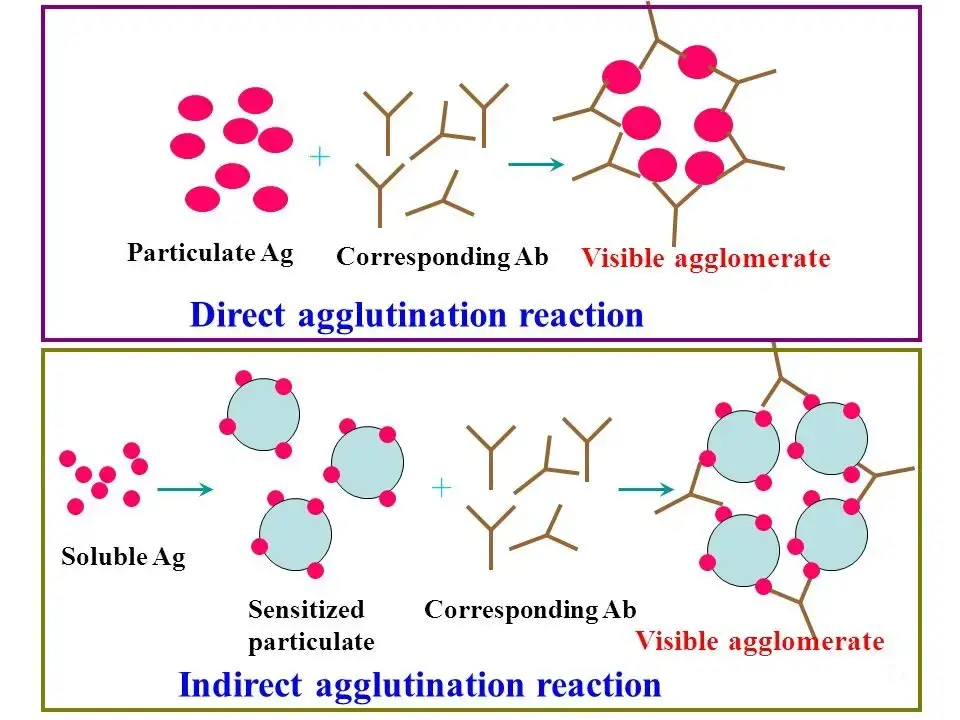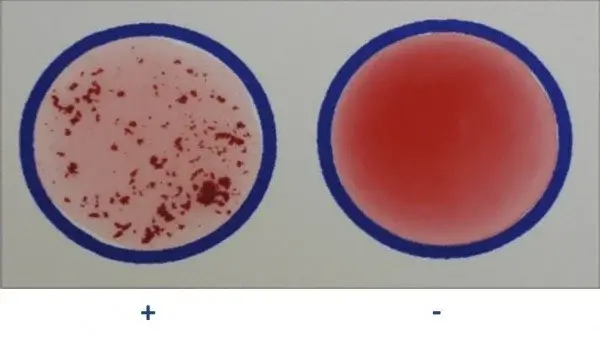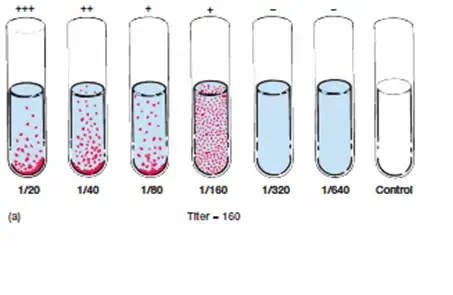In this article we will learn about Agglutination test definition, Types, Uses, Advantages, Disadvantages, Aim of Agglutination Test, Specimen collection, application of Agglutination test and finally Examples of Agglutination test.
Agglutination Test
Agglutination Test is a clinical assay used for the detection of Antibody or Antigen in body fluids such as saliva, urine, cerebrospinal fluid, or blood.
In agglutination test antibodies react with antigens on cells and form visible clumps or aggregates which is called agglutinates. We can see these clumping in naked eyes.
The antibodies are involved in the formation of clumping in the Agglutination Test is known as agglutinins.
This agglutination test is specific, hence the antigen combines only with its homologous antibody and form an antigen-antibody complex or clumps.
This complex is firm and irreversible. The firmness of this complex depends on the affinity and avidity of the reaction.
Agglutination reaction is better to take place in IgM as compare to IgG. Agglutination reactions can be inhibited if the number of antibodies is higher than the number of antigens. This type of inhibition is called prozone phenomenon.
The prozone phenomenon occurs when either an antibody or an antigen is present in excess.
In 1965, Singer and Plotz first introduced this test and was described as the Rheumatoid Factor Test
The interaction between antibodies and antigens results in a visible clumping or aggregates, which is called agglutination reaction.
Prozone phenomenon
When an excess amount of antigen and antibody cause inhibition of agglutination reaction it refers to the prozone phenomenon.
The prozone phenomenon also increases the number of antibody binding sites compared to epitopes present in the antigens.
Which results, antibodies bind to antigen only univalent instead of multivalently. Those antibodies which chose univalent binding they can not cross-link one antigen to another.

Aim of Agglutination Test
The main purpose of the Latex agglutination test is to detect the presence of antibodies produced against a particular antigen or virus or bacteria.
Specimen collection
Agglutination test used in all types of body fluids to detect antigens and antibodies, for example, Saliva, Urine, Blood, Cerebrospinal fluid (lumbar puncture).
After the collection of samples, they mixed with latex beads coated with a specific antibody or antigen. If the suspected antigen or antibody is present, it will form a visible clumps. It takes 15 minutes to an hour for the results of this test.
Types of Agglutination

Agglutination is classified into three groups based on the reaction types between antigen and antibody.
1. Direct Agglutination
In this technique cells or insoluble particles or antigens are agglutinated directly with the antibodies.
Direct agglutination test is divided into two classes, such as;
A. Slide Agglutination:
In this method, blood samples are mixed with Anti-A, Anti-B, and Anti-D antibody on a slide to perform the agglutination.
- In this process, at first, the sample specimen is taken on a clean microscopic slide.
- Add antiserum on this sample drop.
- Then mix them with the help of a sterile toothpick.
- Allow them to agglutinate.
- Observe the formation of agglutination.
In slide agglutination reaction positive result is indicated with the formation of a clump of simple. In this test, the clumping of the test sample will appear within a few minutes.
Application:
- This method is used for the identification of bacteria from clinical specimens.
- used for blood grouping.

B. Tube Agglutination:
This technique is used for the detection of a specific antibody in a blood sample with the presence of a constant amount antigen.
- In this technique at first, the serum to be tested is serially diluted in test tubes.
- The standardized amount of known antigen is added to each Test tube and mixed well.
- The tubes are incubated at a suitable temperature.
- After a few hours of incubation, agglutination is completed and tubes are examined for clamping.
- Results are usually expressed as tighter. The highest dilution of test serum at which positive agglutination occurs.
Application:
- Used for brucellosis test.
- Used in Widal test for diagnosis of for the diagnosis of enteric fever.
- Used for Weil-Felix reaction in serodiagnosis of typhus fevers.
- Used for the Paul-Bunnel test.

2. Indirect Agglutination
When a soluble antigen used in an agglutination reaction it is often coated on a carrier particle, and agglutination takes place on the surface of the carrier molecule, this type of reaction called indirect agglutination reaction.
In indirect agglutination test RBC, latex or bentonite, etc used as carrier molecules.
3. Reverse passive agglutination
In this technique, the antibody is coated on a carrier molecule which then detects antigen in the patient’s serum.
Used of Agglutination Test
- Agglutination Test used for blood grouping and Cross-matching.
- Agglutination Test is basically used to determine whether the quantity of antibodies or antibody titer against a particular infectious agent in a patient’s blood is increasing.
- This reaction test often used to diagnose disease due to a microorganism that is difficult to detect or grow directly in the clinical laboratory.
- Agglutination Test is used for the detection of antibodies to the three species of Brucella that cause brucellosis or undulant fever; Franciscella tularensis, the cause of tularemia; and antibodies to Epstein-Barr virus, the cause of mononucleosis.
- Used o detect the antigen of Cryptococcus neoformans in cerebrospinal fluid or serum.
- This test also used to detect capsular antigens of Pneumococcus, Haemophilus influenzae and Meningococcus.
- agglutination test also used to detect the presence of beta-hemolytic Streptococcus.
- This test used to detect antistreptolysin O antibody.
- agglutination test used for detection of Clostridium difficile toxins A and B, rotavirus, and Escherichia coli 0157:H7 from suspect colonies of E coli.
Advantages of Agglutination
- Require less time.
- Easy to perform.
- High degree of analytic sensitivity.
- It can detect an enormous variety of antibodies.
Disadvantages of Agglutination
- Their susceptibility to false-negative reactions caused by the prozone phenomenon.
- The reactions are at best semi-quantitative.
Examples of Agglutination test
Widal test
Widal test is a test tube agglutination test. In widal test, two types of typhoid bacillus antigen are used such as H or the flagellar antigen and the O or the somatic antigen. This test is performed in this following steps;
- In this test involve the addition of a sample of dead typhoid bacterial cells to a series of test tubes containing the patient’s serum, which is previously serially diluted.
- The test tubes are incubated at 37-degree centigrade for 30 minutes.
- Centrifugation is performed and measures the amount of agglutination occurred.
- In this test, The higher the titer, the greater is the antibody response of the individual to the disease.
Application:
Use for diagnosis of enteric disease.
Hemagglutination
- Hemagglutination also known as haemagglutination.
- Hemagglutination test performed for typing of RBCs.
- In this method first, the test blood sample is mixed with antisera (Anti-A, B, D) on a clean slide.
- If the antigen is present in the blood sample, it will formed a visible clumps on the slide, and it will reveal the blood type of individuals.
Application:
- Used for blood typing or Blood Grouping.
- Used for the quantification of virus dilutions in a haemagglutination assay.
Latex agglutination
- This test is performed by binding antibodies or antigens to the surface of an artificial carrier called latex beads, such as polystyrene.
- If antigen present in the test sample it will be attached with the combining sites of the surface antibody of the latex beads, by forming cross-linked aggregates of latex beads and antigen.
- The size of latex beads varies from 0.8µm to 1um.
Application
- Used for detection of capsular antigens of Pneumococcus, Haemophilus influenzae and Meningococcus.
- Helps in detection of antigen to Cryptococcus
Coagglutination
- Coagglutination is similar to latex agglutination, in this process antibodies are attached with a particle to increase the visibility of agglutination reaction, which is formed between antigen and antibody.
- In this method, At first killed particles are treaded with Staphylococcus aureus .
- Staphylococcus aureus has an antibody- binding protein, called protein A, in their cell walls.
- Staphylococci bind only the base of the heavy chain portion (Fc) of the antibody, leaving both (Fab)antigen-binding ends free to form complexes with specific antigen.
Application
- Used for the detection of antigens in serum, urine, and CSF.
- Several commercial suppliers have prepared coagglutination reagents for identification of streptococci, including Lancefield groups A, B , C, D, F , G and N; Streptococcus pneumoniae; Neisseria meningitides; N gonorrhoeae; and Haemophilus influenzae types A to F grown in culture.
Reference
- https://en.wikipedia.org/wiki/Agglutination_(biology)
- http://www.biosciencenotes.com/agglutination/
- https://microbeonline.com/immunology-note/
Yes, I love this place